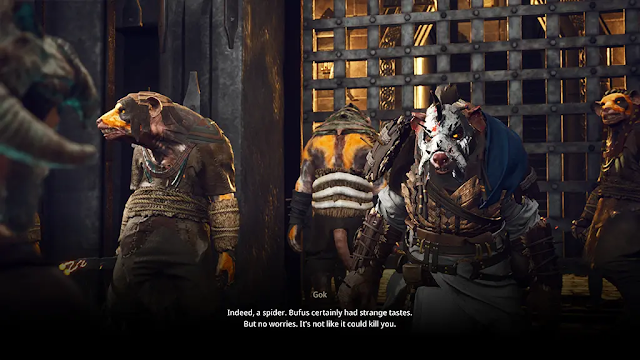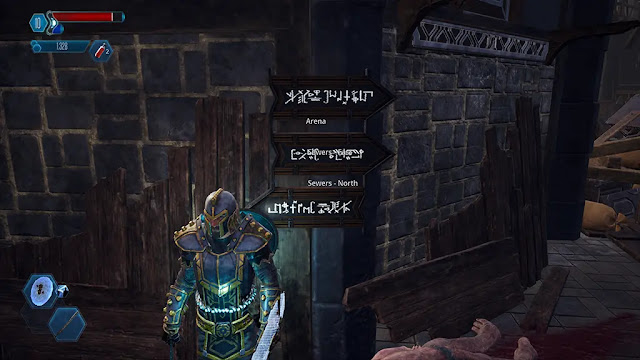The Last Oricru by developer GoldKnights and publisher Prime Matter—Microsoft Xbox Series X|S review written by David with a copy provided by the publisher.
Estimated reading time: 10 minutes
The Last Oricru starts off with you trapped in a coffin-like pod, from inside which you watch another one of these things get cracked open by some lumbering, zombie-like creature. This is followed by your own coffin getting cracked open, and you’re promptly stabbed through the gut by one of these things. Yay! It’s a soulslike and you start the game by dying. Plot twist here though, instead of being dead the whole game, you’re actually immortal! When you die, you’re reborn through the weird glowing belt that exists outside of your clothing regardless of improbability or function. I was actually pretty disappointed that this wasn’t used as an opportunity for a diegetic health bar like Isaac got in Dead Space but alas, this is not the case.
Wake up to an insulting man that simultaneously goes out of his way to be a donk, and explains the basic function previously mentioned, and then follow a humanoid rat to the other guy who’ll train you. The whole vibe of these two seem like a weird cross between pseudo-viking fiction aesthetic and a thick dose of orientalism for the “monk” feeling you’re supposed to get from them. Meet a couple other humans on the way and confirm that no, these Naboru people are not humans. They both have very different opinions on the situation though, and following up with both of them will reveal a bit about the central conflict. Not anything you’ve missed this far, but just in case , you get two opinions on whether the Ratkin deserve the apparent slavery they’re in or not.
Two sides to pick from, and one is justifying slavery with lines pulled straight out of Race Science nonsense. Okay then. Your first bit of training involves going to get weapons from a ratkin in the armory named Gok. I actually really enjoy Gok’s lines here, he’s good at playing into the “stupid rat” stereotype he gets treated with, and has a lot of jokes about “lots of rat iron-y” to come. You follow this up by being told to execute a ratkin for stealing from the kitchen. Hold up here. Argue against that and suddenly Tobias, your trainer, has a story about how his poor niece got taken in the night to their hole and eaten, sacrificed for their religion’s rituals. Blood Libel just casually wrapped into the way this whole racial conflict is cast.
I wanna take a moment out of this to just wonder why this story needed to be told this way. Before we go any further and learn any more details about this setup. Why do we need to tell stories of realistic racism using real world racism as just set dressing. Set dressing for a conflict between shiny armored, city-dwelling, alabaster nobility and their barbaric rat slaves. Maybe they’re being heavy handed, but they’re doing it wrong. For centuries Europeans used claims of children being taken, eaten, sacrificed as an excuse to evict, harass, abuse, and murder my people. Someone I grew up with commented about how they always thought I’d looked like a rat when I started being more open about my embracing of my roots in a Jewish American immigrant family.
American imagery frequently casts traditional African and Indigenous American cultural and religious practices as barbaric. They're using the same claims and the same nonsense racial science to justify real world slavery, and abuse of black and indigenous peoples across both American continents and everywhere they got dragged to serve. Rodents are a favorite depiction by racists of their targets. The whole setup of this story is just itchy to me. Tell stories about racism. Reject it heavy-handedly if that’s the aim here, but don’t pull real examples and slap them ham-fistedly across your “partially terraformed planet” science-fantasy setting. It’s gross, and made the game harder to play than the utter lack of direction it’s levels often have. This all continues to this day in real life.
Moving onto the next bit then. You get your first real option after killing Durg, you can’t get out of it that I found, and Gok is upset about it. Before you go to the next portion of the training though, and the game doesn’t mention that part, Gok wants a medical kit, so you get to explore a bit and learn just how much padding the game has in play-time by its unnecessarily labyrinthine level design and no suggestion of a map or compass. Maybe I’m just bad at navigating. Do the training, win or lose the next fight it doesn’t matter, the queen arrives!
And now we have a stealth portion to a game with zero stealth mechanics other than “Lol he looked at you” and then you die. (You don’t die here but later you do). The queen is looking for artifacts like the one you either succeeded at hiding or didn’t, and you get the chance to pick a side. Respect the Ratvolution. There are some fun dialogue bits throughout this, the giant spider fight is harder than the next three “boss” fights combined just because of animation nonsense par for the subgenre.
Leveling up is important, especially because your carry weight only goes up if you want it to, and gear weight affects your movement and attack speed. These terminals pop up every now and then, the first is in the dungeons of the monastery you start in, the game hands this to you directly, and you’ll recognize them from a mile away when you see them from here. They serve as reset points. Your health potions and resources refill when you come in or die, but so to do the enemies respawn. Killing things collects Currency, death removes Currency. If you make it back to your death spot you can pick up most of what you lost, if you die again it’s gone forever. Many of you know the drill I’m sure.
The combat isn’t overly punishing. It doesn’t feel like it has much weight to it, and what actually stops an animation or attack seems inconsistent, but that last bit might be a failing on my part. The terminals are how you access level-ups, gear upgrades, story updates, and activate the co-op function, which itself was pretty cool. There’s some synergy combat features they included just for co-op mode, which is both local split screen and online.
If these games aren’t your vibe because of that combat barrier that does exist, it’s got a switch to Story difficulty so you can just go through the adventure they wrote. And it is a pretty entertaining one. I like that I can’t tell how much I can actually trust Gok. I loved finding the pieces of Bufus’ armor and learning how he died before we got there, saving the surviving Brather responsible. The visuals are consistently great too. While there’s some Indie Jank, mostly in dialogues (necklaces like to vibrate pretty violently), it’s not disruptive in a way I noticed and the character models are solidly detailed.
The world too is absolutely beautiful. There’s a view you get early on of a seduction of the cover art that’s currently serving as my Xbox’s home screen. Problems with the type of story they’re trying to tell being told the way they’re trying to tell it aside, I do find myself enjoying that aspect of the game. Knowing I’ll come back to make other choices to see just how far the game changes, and finding myself wanting to see more. I’m a sucker for setting though, what can I say. Talking any further about the progression of the game is just spoilers for their own sake, maybe I'll make a deeper story analysis, but not in this article.
With a heavy handed and uncomfortable racial conflict at its center, every choice alters the way the game progresses. Fight this Soulslike fight alone, or with a friend, but maybe wait for the sale.
Score: 6 / 10

















0 comments:
Post a Comment